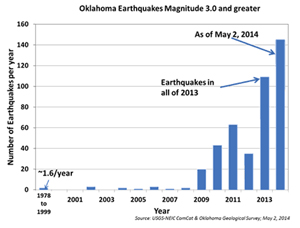 A U.S. Geological Survey and Oklahoma Geological Survey analysis has found that 145 earthquakes of magnitude 3.0 or greater occurred in Oklahoma from January 2014 through May 2. The previous record, set in 2013, was 109 earthquakes, while the long-term average earthquake rate, from 1978 to 2008, was just two magnitude 3.0 or larger earthquakes per year. Important to people living in central and north-central Oklahoma is that the likelihood of future, damaging earthquakes has increased as a result of the increased number of small and moderate shocks.
A U.S. Geological Survey and Oklahoma Geological Survey analysis has found that 145 earthquakes of magnitude 3.0 or greater occurred in Oklahoma from January 2014 through May 2. The previous record, set in 2013, was 109 earthquakes, while the long-term average earthquake rate, from 1978 to 2008, was just two magnitude 3.0 or larger earthquakes per year. Important to people living in central and north-central Oklahoma is that the likelihood of future, damaging earthquakes has increased as a result of the increased number of small and moderate shocks.
 Oklahoma’s heightened earthquake activity since 2009 includes 20 magnitude 4.0 to 4.8 quakes, plus the largest earthquake in Oklahoma’s history – a magnitude 5.6 earthquake that occurred near Prague on Nov. 5, 2011. The 2011 Prague earthquake damaged a number of homes and the historic Benedictine Hall at St. Gregory’s University in Shawnee. Prior to the 2011 Prague earthquake, the largest earthquake of Oklahoma’s history was a magnitude 5.5 earthquake that occurred in 1952 near El Reno and damaged state buildings in Oklahoma City.
Oklahoma’s heightened earthquake activity since 2009 includes 20 magnitude 4.0 to 4.8 quakes, plus the largest earthquake in Oklahoma’s history – a magnitude 5.6 earthquake that occurred near Prague on Nov. 5, 2011. The 2011 Prague earthquake damaged a number of homes and the historic Benedictine Hall at St. Gregory’s University in Shawnee. Prior to the 2011 Prague earthquake, the largest earthquake of Oklahoma’s history was a magnitude 5.5 earthquake that occurred in 1952 near El Reno and damaged state buildings in Oklahoma City.
“While it’s been known for decades that Oklahoma is ‘earthquake country’, we hope that this new advisory of increased hazard will become a crucial consideration in earthquake preparedness for residents, schools and businesses in the area,” said Dr. Bill Leith, Senior Science Advisor for Earthquakes and Geologic Hazards at USGS. “Building owners and government officials should have a special concern for older, unreinforced brick structures, which are vulnerable to serious damage during sufficient shaking.”
 Collaborative USGS and OGS research to understand earthquake rate increase in the central Oklahoma area includes quantifying the changes in earthquake rate, assessing the implications of the increased small and moderate earthquake activity for large earthquake hazards, and evaluating possible links between these earthquakes and wastewater disposal from oil and gas production activities. The OGS is also focused on seismicity in north-central Oklahoma.
Collaborative USGS and OGS research to understand earthquake rate increase in the central Oklahoma area includes quantifying the changes in earthquake rate, assessing the implications of the increased small and moderate earthquake activity for large earthquake hazards, and evaluating possible links between these earthquakes and wastewater disposal from oil and gas production activities. The OGS is also focused on seismicity in north-central Oklahoma.
To more accurately determine the locations and magnitudes of earthquakes in Oklahoma, the OGS has increased the number of monitoring stations and now operates a seismograph network of 15 permanent stations and 17 temporary stations, many of which are on loan from the USGS. There are also three permanent seismic stations operated by the USGS and the Incorporated Research Institutions for Seismology. Data from this network are shared in real-time with the USGS National Earthquake Information Center, which provides 24×7 reporting on earthquakes worldwide.
